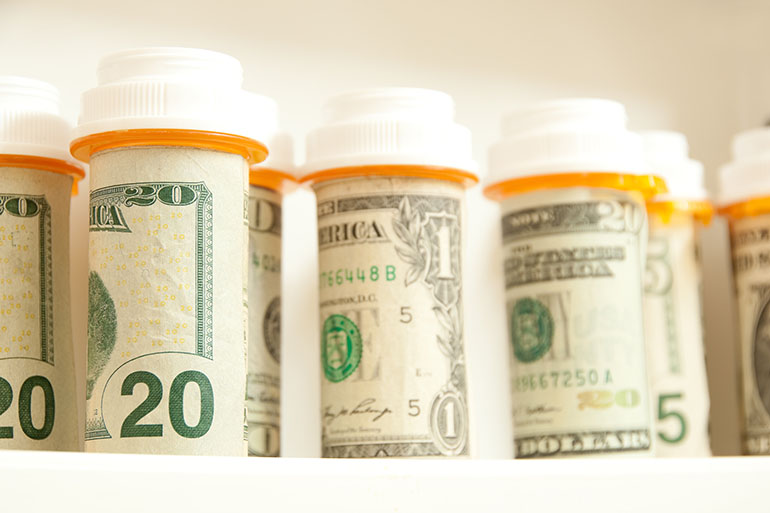Medicare and its beneficiaries aren’t the winners in the behind-the-scenes rebate game played by drugmakers, health insurers and pharmacy benefit managers, according to a paper published Tuesday in JAMA Internal Medicine.
The paper, which dives into the complex and opaque world of Medicare drug price negotiations, finds that rebates may actually drive up the amount Medicare and its beneficiaries pay for drugs — especially for increasingly common high-priced drugs — and it offers some systemic solutions.
“How these rebates and price concessions happen between the manufacturer of the drug and the PBMs [pharmacy benefit managers] and health plans can directly impact patient cost in a big way,” said the paper’s lead author, Stacie Dusetzina of the University of North Carolina-Chapel Hill’s pharmacy school.
The paper’s findings and proposed solutions come as President Donald Trump’s administration, Congress and state lawmakers grapple with ways to control drug prices and overall health spending. Trump’s administration has said it wants to lower drug prices and hinted at mandating rebates in Medicare. Leaders on Capitol Hill have called for Medicare price negotiations.
In the JAMA paper, Dusetzina cites the EpiPen as one example. Last year, executives at Mylan, the maker of the EpiPen, said the list price of the drug for life-threatening allergic reactions was $600, but the company earned $274 after rebates and other fees.
That savings, though, isn’t necessarily passed on to patients in Medicare’s system. Instead, the money tends to be swallowed up by health insurers and middlemen like pharmacy benefit managers.
And, even though patients don’t pay list prices for their drugs, those high prices (like $600 for the EpiPen) are used to calculate how much Medicare covers for any individual patient — and sometimes what patients pay out-of-pocket, Dusetzina said.
“We’ve heard over the years that the list price doesn’t really matter, that it’s not the real price,” Dusetzina said. “It matters.”
The way it matters is not easily apparent. Here’s what happens: When a Medicare patient picks up a prescription, what they pay toward it is generally based on that higher list price and not the price after rebates, so the amount the beneficiary pays is scaled upward as a result.
And Medicare uses that high-end list price to calculate how rapidly beneficiaries reach the dreaded doughnut hole, where patients pay a bigger share of the price of the drug after their spending hits $3,700, the 2017 benchmark. Once through the doughnut hole, Medicare picks up the bulk of the drug’s cost.
High list prices drive patients into and out of the doughnut hole faster, raising their out-of-pocket costs and Medicare expenditures.
Dusetzina and co-authors Rena Conti, assistant professor of health policy and economics at the University of Chicago, and Dr. Peter Bach, director of Memorial Sloan Kettering Cancer Center’s Center for Health Policy and Outcomes, propose solutions to this problem.
Bach called the current Medicare system “absolutely devastating for people on high-cost specialty drugs.”
Bach’s drug pricing lab at Memorial Sloan Kettering offers an interactive tool for comparing how dollars shift when using the list price and post-rebate price.
The authors recommend that patients should be charged flat-dollar copays rather than coinsurance charges, which are based on a percentage of the drug’s price. The copays could be tiered, depending on the cost of the drug, the paper suggested.
This solution comes, in part, because the number of Medicare enrollees paying coinsurance for their drug, rather than a flat fee, has increased to 58 percent last year from 35 percent in 2014, the paper notes.
Another tactic would be to address the underlying disconnect between rebate negotiations and savings for Medicare and beneficiaries. The authors suggest that incentives for health insurers need to change to require health plans to pay more of the drugs’ costs after beneficiaries pass through the doughnut hole.
In addition, Dusetzina said, using the post-rebate amount in Medicare’s calculations would allow Medicare beneficiaries to move through the doughnut hole more slowly. That would save both patients and Medicare money.
“It really just stops us from accelerating people through the benefit,” Dusetzina said.
Last month, the Pharmaceutical Research and Manufacturers of America, which represents the pharmaceutical and biotechnology industry, launched a “Share the Savings” advertising campaign calling for public education about how the savings from rebates don’t actually get passed on to commercial insurance patients.
In an email, PhRMA’s Holly Campbell said the group’s commissioned research has found that rebates and discounts have nearly doubled from 2013 to 2015. Campbell said PhRMA believes “insurance companies should share more of the rebates and discounts they receive with patients.”
America’s Health Insurance Plans, which represents the insurance industry, calls the assertion that rebates and other discounts aren’t passed along “absolutely inaccurate” and noted the “true issue” is that drug prices continue to skyrocket “with no clear explanation as to how prices are set.” Insurers pass the savings from rebates on in different ways, including lower monthly premiums and co-pays, said AHIP’s Cathryn Donaldson.
Dusetzina said there is one caveat to the Medicare study: It is unclear how many drugs get a rebate and for how much because there is lack of transparency when it comes to rebates.
The paper’s final suggestion is about transparency. It says that federal regulators should require rebate data to be reported for individual drugs and then use that information to change Medicare’s benefit design in a way that “would lead to savings” for Medicare and its enrollees.
This story was produced by Kaiser Health News, an editorially independent program of the Kaiser Family Foundation.
